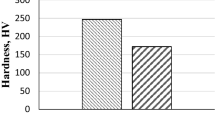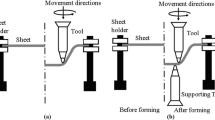The results of checking of the physical and mechanical characteristics of carbon materials by the dynamic indentation method are presented. It is shown that the method and the devices created allow one to control the hardness, strength, and elastic modulus of the isotropic pyrolytic graphite and carbon laminates used to manufacture articles for the rocket and space technology.
Similar content being viewed by others
Avoid common mistakes on your manuscript.
Introduction
At present, a considerable gap between the process of creation of carbon materials (CMs) and the development of means of their nondestructive testing is observed. In the rocket and space technology, as a rule, two kinds of CMs are employed: an isotropic pyrolytic graphite (IPG) and layered carbon-fiber-reinforced plastics (CFRPs), which are of increased interest from the viewpoint of checking their properties. The nondestructive testing (for example, ultrasonic) methods of such CMs do not allow one to obtain a local estimate of the properties of a material, whereas checking the properties of CMs by using standard methods implies destruction of witness specimens. In this connection, most actual and claimed are the elaboration and development of new nondestructive methods of testing CMs and devices for their realization.
In the present study, the efficiency of a dynamic indentation method (DIM) is assessed. The method consists in hitting an object with a rigid indenter, with a simultaneous continuous registration of the process of contact interaction between the indenter and material. The distinction of this method from the method of tool indentation consists in impact introduction of an indenter into a material. The method was practically realized in an IPM-1K instrument complex created at the Institute of Applied Physics of the Belarus Academy of Sciences.
Theoretical Part
The typical diagram of introduction of an indenter into a CM is shown in Fig. 1.
To check the elastic modulus E and hardness of an IPG material by introducing an indenter in the form of sphere into it, we can use the known relations [1–3]
where P max is the maximum load, R i is the radius of indenter, h max is the maximum depth of introduction, h p is the depth of the plastic print, and μ is the Poisson ratio of the material.
The main problem in measuring the properties of layered materials is the choice of such parameters of indentation that will raise the sensitivity of the method to varying properties of a material in different directions relative to the direction of reinforcement. In this connection, it seems efficient to employ the DIM and a wedge-shape indenter. In the present study, the indentation was carried out with orientation of the indenter at various angles to the reinforcement direction of CFRP (Fig. 2).
The case of indentation of a wedge-shape indenter is not so trivial as the introduction of a spherical indenter. In this case, the elastic modulus was found by using the approach described in [4], within the framework of which the maximum force P max applied to a specimen is determined as the product of the stress σ and the projection of contact surface of the indenter and material, A ; the stress σ, based on the relation σ = ε E *, is found from the formula
where \( 1/\left(2 \tan \frac{\varphi }{2}\right) \) is the strain ε of the material, φ is the wedge angle, and E ∗ is the reduced elastic modulus of the indenter-material system. The projection of contact surface A, expressed in terms of the parameter of penetration depth h, is described by the relation
where b is the width of wedge (in our case, b = 2.38 mm).
In view of Eqs. (1)-(4) and [1], the expression for E takes the form
In Eq. (4), the parameter h is equal to the contact depth of penetration h c (h c = h max − hs, where h s is the elastic deflection of the contour of print determined by the relation ∈ = P/S, where ∈ is a constant dependent on the shape of indenter; S is the contact rigidity). Further, as in the case of spherical indenter, we find an expression for the hardness of layered materials:
where ε = 0.73, proceeding from the assumption that the distribution of pressures in the wedge–material contact region, is similar to that in the case of indentation of a cone [5].
Experiment and [Discussion of the]Results
Within the framework of investigations of IPG, several tens of specimens cut out from real products were tested. The results of tests on IPG by using the standard methods and the DIM made it possible to establish correlations between the characteristics determined by the methods mentioned (compression strength σ com, elastic modulus in compression E сom, and Vickers hardness H V), described by following equations:
Determination of the strength of IPG was based on the presence of its correlation with the value of hardness, which earlier had been determined only for metals. The results obtained allowed one to estimate for the first time the physical and mechanical properties of IPGs employed to manufacte sealing rings of rocket engines.
Experimental investigations of layered CFRPs were carried out both on single- and multilayered specimens. Figure 3 shows the test results for a two-layer carbon composite with an orthogonal lay-up of layers. An analysis of the resulting data allows us to distinguish four characteristic variants of response of the material: (i) the energy of impact W is insignificant (curve 1), the penetration of indenter in the material is insignificant and depends mainly on the properties of fibers of the upper layer; (ii) with increase in W (curve 2), the contribution of properties of the matrix grows and, at γ = 0°, they are manifested most markedly; at the same time, the penetration depth is not yet sufficient for the properties of the lower layer to noticeably affect the general response of the material; (iii) the value of W is sufficient (curve 3) to catch the influence of properties of the fibers of the lower layer at values of γ close to zero; (iv) the effect of the lower layer is observed at any orientation of indenter (curve 4) relative to the reinforcement axis of the upper layer (the drop in Е at angles γ close to 90° is explained by the increased influence of properties of the matrix of the lower layer).
In practice, of interest is also to determine a relation between the parameters measured by using the DIM and the regulated characteristics of materials [6]. With this purpose, the standard tests of single-layered specimens were performed [7] (Fig. 4).
Ten specimens were tested in each series, and the average of the elastic modulus and strength in tension were calculated (along the fibers — index 1 and across the fibers — index 2). As seen from the data in Fig. 4a,b, a steady correlation between the elastic moduli measured by the standard method (E +1 and E +2 ) and obtained by the method suggested here exists. Also, a relation between the hardness Н and the tensile strengths σ +1 and σ +2 is observed (Fig. 4c,d). The presence of such relations makes it possible to assert that DIM is an effective means of nondestructive testing of composite materials that allows one to estimate the anisotropy of material properties.
Conclusions
The results of investigations show that the employment of a wedge-shape indenter enables one to raise the informativeness of checking of materials: a possibility of estimating the physicomechanical characteristics in various directions relative to the reinforcement axis of a composite material arises. The data obtained made it possible to establish steady correlations between the parameters of the process of dynamic deformation of carbon materials and their properties — the strength and elastic modulus.
References
W. C. Oliver, “Measurement of hardness and elastic modulus by instrumented indentation: Advances in understanding and refinements to methodology,” J. Mater. Res., 19, No. 1, 3-20 (2004).
A. P. Kren, “Determination of the relaxation function for viscoelastic materials at low velocity impact,” Int. J. Impact Eng., 37, No. 2, 170-176 (2010).
A. P. Kren, “Determination of the viscoelastic properties of elastomeric materials by the dynamic indentation method,” Polym. Test., No. 4, 369-375 (2004).
V. L. Popov, Kontaktmechanik und Reibung. Ein Lehr-und Anwendungsbuch von der Nanotribologie bis zur numerischen Simulation, Springer, Berlin (2009).
K. L. Johnson, Contact Mechanics, Cambridge University Press (1987).
GOST Р 54072-2010. Products of Space Facilities. Composite Polymer Materials. Nomenclature/Range/Terminology/Classification of Indices. Introduced 30.06.2011, Standartinform, Moscow (2011).
GOST 25.601-80. Calculations and Tests in Strength. Methods of Mechanical Tests of Composite Materials with a Polymeric Matrix (Composites). A Test Method of Plane Specimens in Tension at a Normal, Elevated, and Lowered Temperatures. Introduced 01.07.1981, Gosud. Komit. SSSR Standart. (2005).
Author information
Authors and Affiliations
Corresponding author
Additional information
Translated from Mekhanika Kompozitnykh Materialov, Vol. 51, No. 2, pp. 323-328, March-April, 2015.
Rights and permissions
About this article
Cite this article
Kren, A.P., Protasenia, T.A., Arnautov, A.K. et al. Complex of Devices for Determining the Physical and Mechanical Properties of the Carbon Materials Used in the Rocket and Space Technology by the Impact Indentation Method. Mech Compos Mater 51, 225–230 (2015). https://doi.org/10.1007/s11029-015-9493-8
Received:
Published:
Issue Date:
DOI: https://doi.org/10.1007/s11029-015-9493-8








